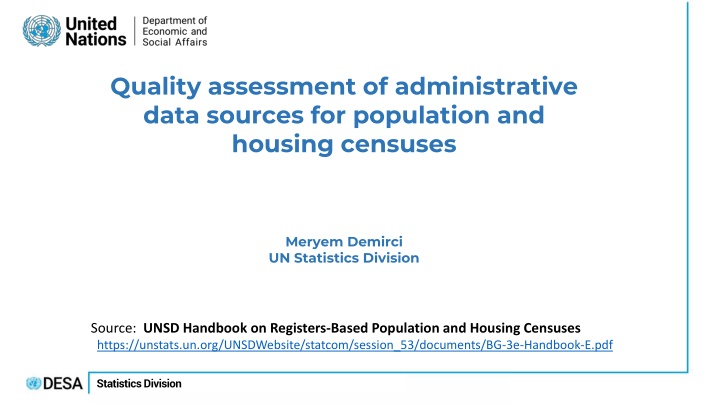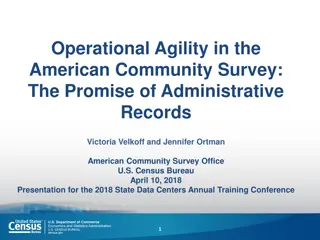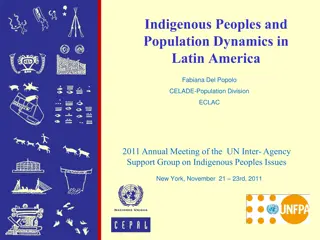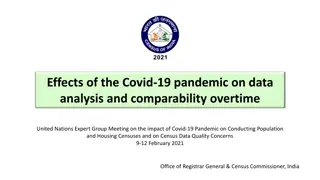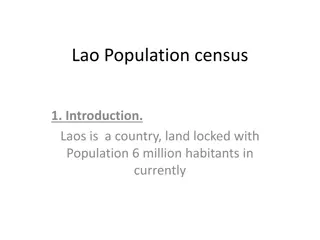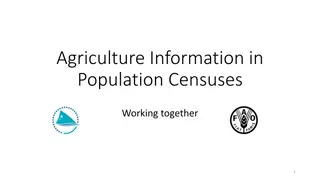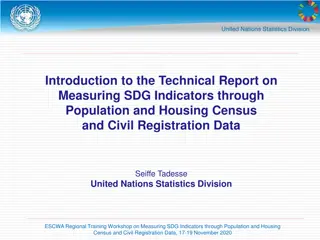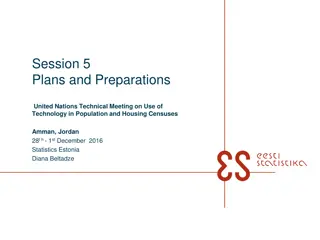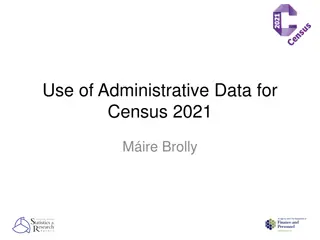Quality Assessment of Administrative Data Sources for Population and Housing Censuses
Quality assessment and management play a crucial role in census operations, regardless of the methodology used. This involves assessing the quality of input data, process quality, and output quality, impacting decision-making on data integration, statistical results dissemination, and the need for field data collection. The stages of quality assessment correspond to the statistical processes of the census, ensuring accurate and reliable census estimates.
Download Presentation

Please find below an Image/Link to download the presentation.
The content on the website is provided AS IS for your information and personal use only. It may not be sold, licensed, or shared on other websites without obtaining consent from the author.If you encounter any issues during the download, it is possible that the publisher has removed the file from their server.
You are allowed to download the files provided on this website for personal or commercial use, subject to the condition that they are used lawfully. All files are the property of their respective owners.
The content on the website is provided AS IS for your information and personal use only. It may not be sold, licensed, or shared on other websites without obtaining consent from the author.
E N D
Presentation Transcript
Quality assessment of administrative data sources for population and housing censuses Meryem Demirci UN Statistics Division Source: UNSD Handbook on Registers-Based Population and Housing Censuses https://unstats.un.org/UNSDWebsite/statcom/session_53/documents/BG-3e-Handbook-E.pdf Statistics Division
Quality assessment Quality assessment and management is an integral part of the census operation regardless of types of census methodologies- either conducted with full-field enumeration or with wholly administrative registers or combination of registers and field data collection It is overarching process covering all phases of censuses-quality of one phase has an impact on the quality of next phase In statistics, quality used to be primarily associated with accuracy of data, but it is widely recognized that there are other important dimensions to quality Statistics Division
Stages of quality assessment Source quality Input data quality Process quality Output quality -Assessment of changes in the quality of data which results from data integration and processing of the admin data -Quality assessment of raw admin data, as it is supplied to NSO by the administrative authorities -Metadata-based assessment -Quality assessment of admin data sources - Overall quality assessment of the statistical results as disseminated to users Statistics Division
Stages of quality assessment Source quality Output quality Input data quality Process quality The results of the quality assessment of administrative sources and the input data will be used to: decide administrative sources that will be used for creating/updating integrated statistical registers decide whether there is a need for field-based data collection for missing census information(such as surveys or full-field enumeration) Statistics Division
Stages of quality assessment for administrative data sources Statistical processes for registers-based censuses Quality assessment Stages of the quality assessment of administrative registers and the census data derived from them are broadly corresponding to the stages of the statistical processes of the census Identification of data sources Source quality Input data quality Data transfer Designing the quality assessment process through these four stages will help ensure that census estimates are based on the most appropriate sources and methods Data Process quality processing/ integration Output production Output quality Statistics Division
Source quality dimensions Representation error o Alignment of the units in the register with the census target units (such as persons) *what laws and regulations define who will be included/excluded in administrative data sources (such as population register) ? *what methods/procedures are used to include/update/exclude units (such as persons in the administrative source? o Coverage against the census target population * does the coverage of the population register meet the needs of the census? * the evidence of under and/or over-coverage? Population groups that require special attention Under-coverage Refugees Undocumented migrants Foreigners living in the country Homeless New-born babies Who else ? Source Relevance Timeliness Over-coverage Citizens living outside the country Late registration of deaths Who else ? Comparability Accessibility Statistics Division
Source quality dimensions Measurement error o Alignment of concepts and definitions of variables in the registers with the concepts and definitions of the census topics Source Relevance *whether or not the register includes the variables needed for the census? *whether or not the administrative concepts, definitions and classifications for such variables are consistent with those adopted in the census? Timeliness *in case of inconsistency, whether a transformation of the variables is possible to satisfy the requirements of the census? Coherence/ Comparability *if not possible, whether or not it would provide similar information? Accessibility /interpretability Statistics Division
Source quality- Timeliness The difference between the reference date to which the data refer and the date on which they are supplied to the NSO- the longer the delay the less relevant Source Relevance Some examples of information that can be used to assess timeliness *what is the time lag between date of occurrence and date of registration? * What is the time lag between date of registration and date on which the data are supplied to the NSO? * whether or not the register has been completely updated when provided to the NSO? * how frequently the data can be supplied to the NSO for updates or new persons or dwellings? Timeliness Coherence/ comparability Accessibility/ interpretability Statistics Division
Source quality- Coherence and comparability assess the degree to which an administrative source can be successfully linked and combined with other data sources for use in the census Source Some examples of information that can be used for this assessment : Relevance * Does the source include a unique identifier (such as PIN) that is common with the unique key required for the census linkage? * If so, is the identifier available for all of the relevant individuals/ addresses in the source or only for special population groups or geographic areas? * Does the source include a unique combination of variables (such as name, date of birth and address), which could be used for the census linkage? Timeliness Coherence/ Comparability Accessibility/ interpretability Statistics Division
Source quality- Accessibility and interpretability It is important to identify any restrictions that may impact on the NSO s ability to acquire and use an administrative source, such as existing data protection restrictions Source *What is the level of public acceptability? Whether or not an NSO decides to access a particular data source for use in the census may also depend on public acceptance Relevance Timeliness *How easy is it to transfer data? The data supplier might adopt very different data models, formats, schemas, software and hardware to that with which the NSO is familiar Coherence/ Comparability * Is there clear and comprehensive metadata? An assessment of interpretability relates to the existence and availability of comprehensive and clear metadata and documentation about the administrative source Accessibility/ interpretability Statistics Division
Input quality- Validation It is crucial for the NSO to ensure that the transmitted data files are in the required readable format; the databases are structured in a way which can be ingested and read by the NSO s systems Input data quality Some indicators can be used to assess the validity including: * Whether or not the variables supplied are correctly named and formatted (e.g., numerical, categorical, text information, etc.), Validation * Whether or not the correct reference period has been supplied * Whether or not the variables match the expected pre-defined content, established through the metadata collected at the Source Stage Accuracy and reliability Statistics Division
Input quality- Accuracy and reliability In assessing the accuracy of the input data, NSOs should distinguish between o representativeerrors (those relating to the coverage of target population) and o measurementerrors (those relating to the particular variable being considered). Input data quality Basic indicators to assess representation errors include: o the total number of units received (for comparison against expected count); o the percentage of duplicate units A key indicator in assessing under-coverage would be: o the percentage of units in the reference source (traditional census or a complete base register) that are missing in the supplied (administrative) source. while over-coverage can be assessed by: o the percentage of units in the (supplied) source not belonging to the target resident population of the NSO Validation Accuracy and reliability Statistics Division
Input quality- Accuracy and reliability Assessment of measurement errors -Basic indicators to measure the completeness of the characteristic variables supplied within administrative datasets at the aggregate level (such as age, sex, ethnicity, etc) include following: Input data quality o number and percentage of missing values within key variables (such as date of birth and sex); o number and percentage of out-of-range values within key variables (for example a recorded age of 120 years); o number and percentage of implausible values (based on, for example, cross-tabulations of different variables); o prevalence of unexpected frequencies, patterns or outliers, based on frequency/distributional analysis of key variables (aggregate comparisons with external sources, as well as expert knowledge, can also be used to identify data oddities); Validation Accuracy and reliability Statistics Division
Process quality As data held in an administrative source are not collected for statistical purposes, they must be transformed by the NSO in some way for use in the census. Linkage of data through a common identifier Constructing/updating a statistical population register Data processing Dealing with duplications Conflict resolution Updating and Signs of life method for improving the quality of coverage of statistical population register Editing and imputation Validation of census outputs Statistics Division
Conclusions Each country should plan the process of the transition based on availability of administrative data sources assessment of the quality of administrative data source and the quality of input data The transition should be planned gradually, introducing more administrative data sources and variables each time, providing that the registers have been proven to be of good quality As a result of the transition, there may be some changes to definitions of variables, population bases and output classifications The impact of these changes on the quality of statistical outputs should be assessed and the outcomes should be explained to users Statistics Division
Reference documents UNECE Guidelines for assessing the quality of administrative sources for use in censuses https://unece.org/statistics/publications/CensusAdminQuality UNSD Handbook on Registers-Based Population and Housing Censuses https://unstats.un.org/UNSDWebsite/statcom/session_53/documents/BG-3e- Handbook-E.pdf Thank you Email: demircim@un.org Statistics Division
